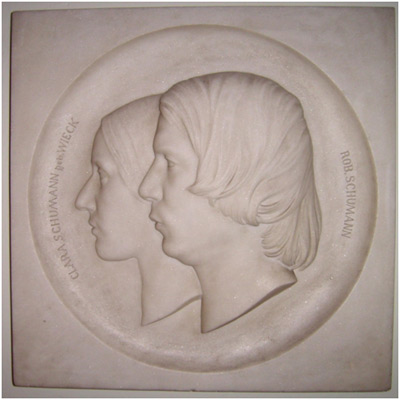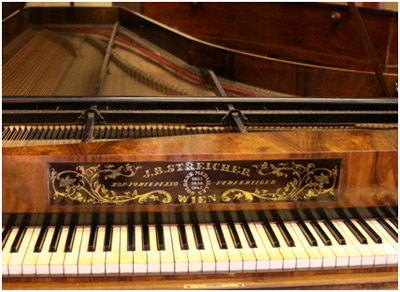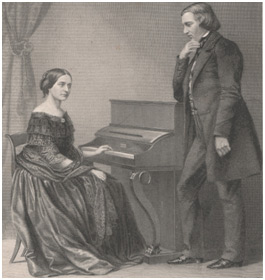- Home
- About
- About SCMS
- Directors
- Artists
- Vera Beths
- Steven Dann
- Marc Destrubé
- James Dunham
- Mark Fewer
- Eric Hoeprich
- Christopher Krueger
- Myron Lutzke
- Marilyn McDonald
- Douglas McNabney
- Mitzi Meyerson
- Pedja Muzijevic
- Anca Nicolau
- Jacques Ogg
- Loretta O'Sullivan
- Lambert Orkis
- Paolo Pandolfo
- William Purvis
- Marc Schachman
- Jaap Schröder
- Andrew Schwartz
- William Sharp
- Ian Swensen
- Lucy van Dael
- Ensembles
- Concerts
- The Collection
- Recordings
- Education
- Donate
Friends of Music Recordings is pleased to announce its third release, Piano Trios of Clara and Robert Schumann, performed by The Castle Trio: Lambert Orkis, piano; Marilyn McDonald, violin; and Kenneth Slowik, violoncello. This CD presents two of the finest chamber works by Clara and Robert Schumann, whose sixteen-year-long marriage was the commingling of the shared musical experience, complimentary creative requirements, and physical and emotional dependencies of two of Germany’s finest Romantic-era musicians.
 Created within a year of each other in 1846-7, the two trios on this disk—Clara’s Trio in G Minor, Op. 17, and Robert’s Trio No. 1 in D Minor, Op. 63— were frequently paired on nineteenth-century concert programs. For this recording, the Castle Trio used a parallel-strung J. B. Streicher piano of 1846 from the Frederick Historic Piano Collection in conjunction with a 1670 violin by Andrea Guarneri and a cello by Carlo Antonio Testore, ca. 1730, set up with gut strings as they would have been in the Schumann’s time.
Created within a year of each other in 1846-7, the two trios on this disk—Clara’s Trio in G Minor, Op. 17, and Robert’s Trio No. 1 in D Minor, Op. 63— were frequently paired on nineteenth-century concert programs. For this recording, the Castle Trio used a parallel-strung J. B. Streicher piano of 1846 from the Frederick Historic Piano Collection in conjunction with a 1670 violin by Andrea Guarneri and a cello by Carlo Antonio Testore, ca. 1730, set up with gut strings as they would have been in the Schumann’s time.
The history of the two works is interesting. In 1839, Robert Schumann heralded the appearance of the D minor opus 49 piano trio of Felix Mendelssohn by naming it “the most masterly trio of the present era, just as, in their times, were the B-flat [Archduke] and D major [Ghost] trios of Beethoven and that of Schubert in E-flat major. It is a beautiful composition that years from now will delight our grandchildren and great-grandchildren.” Schumann did not err in this assessment, for Mendelssohn’s D minor work has continued to occupy a favored spot in the trio repertoire, far surpassing in popularity his C minor trio of some six years later.
 At the time of publication of Mendelssohn’s Op. 49, Schumann was twenty-nine, and embroiled in an effort to marry twenty-year-old Clara Wieck, whose career as a concert pianist was already firmly established. The union was fiercely opposed by Clara’s father Friedrich, who had guided the pianistic development of both. Only after a drawn out legal battle was the couple allowed to wed in 1840. By all accounts, the marriage was extremely felicitous at first, though Clara confided to her diary some nine months into her life as Frau Schumann (and six months into the first of her eight pregnancies prior to Robert’s 1856 death) that “my piano playing is falling behind. This always happens when Robert is composing. There is not even one little hour in the whole day for myself! If only I don’t fall too far behind. Score reading has also ceased once again, but I hope that it will not be for long this time. I can’t do anything with my composing—I would sometimes like to strike my dumb head!” Robert may not have been entirely dissatisfied, for, while he rejoiced in his wife’s talents, he had great difficulty overcoming his rather bourgeois expectations of marriage. While Clara was on tour in Paris shortly before their wedding, for example, Robert had written her: “I have just read your letter in which you write, ‘If I remain in Dresden for one year I will be forgotten as an artist . . .’ Clärchen, you are not really serious—and if you were to be forgotten as an artist, would you not be beloved as a wife? The first year of our marriage you shall forget the artist, you shall live only for yourself and your house and your husband. Just wait and see how I will make you forget the artist—because the wife stands even higher than the artist. If I only achieve this much—that you have nothing more to do with the public—I will have achieved my greatest aspiration.” But despite her husband’s controlling wishes, by 1842 Frau Schumann-née-Wieck’s career was again in full swing. As Nancy Reich observes in her ground-breaking biography of the virtuosa, Clara Schumann: The Artist and the Woman: “Once she realized that wet nurses were available, that the baby could be boarded with relatives, that an additional maid could be hired for a pittance, that motherhood did not necessarily tie her down, she wasted no time. Clara composed, toured, played, and was fêted as in the old days before marriage and childbearing.”
At the time of publication of Mendelssohn’s Op. 49, Schumann was twenty-nine, and embroiled in an effort to marry twenty-year-old Clara Wieck, whose career as a concert pianist was already firmly established. The union was fiercely opposed by Clara’s father Friedrich, who had guided the pianistic development of both. Only after a drawn out legal battle was the couple allowed to wed in 1840. By all accounts, the marriage was extremely felicitous at first, though Clara confided to her diary some nine months into her life as Frau Schumann (and six months into the first of her eight pregnancies prior to Robert’s 1856 death) that “my piano playing is falling behind. This always happens when Robert is composing. There is not even one little hour in the whole day for myself! If only I don’t fall too far behind. Score reading has also ceased once again, but I hope that it will not be for long this time. I can’t do anything with my composing—I would sometimes like to strike my dumb head!” Robert may not have been entirely dissatisfied, for, while he rejoiced in his wife’s talents, he had great difficulty overcoming his rather bourgeois expectations of marriage. While Clara was on tour in Paris shortly before their wedding, for example, Robert had written her: “I have just read your letter in which you write, ‘If I remain in Dresden for one year I will be forgotten as an artist . . .’ Clärchen, you are not really serious—and if you were to be forgotten as an artist, would you not be beloved as a wife? The first year of our marriage you shall forget the artist, you shall live only for yourself and your house and your husband. Just wait and see how I will make you forget the artist—because the wife stands even higher than the artist. If I only achieve this much—that you have nothing more to do with the public—I will have achieved my greatest aspiration.” But despite her husband’s controlling wishes, by 1842 Frau Schumann-née-Wieck’s career was again in full swing. As Nancy Reich observes in her ground-breaking biography of the virtuosa, Clara Schumann: The Artist and the Woman: “Once she realized that wet nurses were available, that the baby could be boarded with relatives, that an additional maid could be hired for a pittance, that motherhood did not necessarily tie her down, she wasted no time. Clara composed, toured, played, and was fêted as in the old days before marriage and childbearing.”
One of Clara’s finest compositions is her piano trio in G minor, written between May and September of 1846 and printed the following year as her opus 17. It is her only published work comprised of all four movements that tradition demanded of a “serious” composition. Mendelssohn owned himself impressed with the trio, singling out the fugato in the development of the last movement for special praise. The second movement, a Lied ohne Wörte or “song without words” very much in the style of Mendelssohn or his sister Fanny Mendelssohn Hensel, strikes many contemporary listeners as particularly successful, yet Clara self-deprecatingly dismissed the entire work as “effeminate and sentimental.”
 Both of the Schumanns suffered during the composition of the trio. In March of 1846, Robert had experienced a temporary relapse of his illness and depression of the previous two years, during which, he reported, there were times when he had “not really been able to abide music for quite a while, as it cuts into my nerves as if with knives,” a sorry state indeed for a man his doctor described as “addicted to his one usual—one and only!—occupation, composing.” (Despite his investment of time in this activity, the substantial income Robert eventually realized from the ongoing sale of his compositions began to arrive only in 1849.) A semi-working vacation for the Schumanns to the East Frisian island spa of Norderney in the North Sea designed to provide some much-needed relaxation was marred by Clara’s miscarriage on 26 July. Notwithstanding the “change in her condition” (which she had initially discovered in early April, just two months after the birth of her previous child) recorded in the Schumann household diary for that date, she played a public concert the next day.
Both of the Schumanns suffered during the composition of the trio. In March of 1846, Robert had experienced a temporary relapse of his illness and depression of the previous two years, during which, he reported, there were times when he had “not really been able to abide music for quite a while, as it cuts into my nerves as if with knives,” a sorry state indeed for a man his doctor described as “addicted to his one usual—one and only!—occupation, composing.” (Despite his investment of time in this activity, the substantial income Robert eventually realized from the ongoing sale of his compositions began to arrive only in 1849.) A semi-working vacation for the Schumanns to the East Frisian island spa of Norderney in the North Sea designed to provide some much-needed relaxation was marred by Clara’s miscarriage on 26 July. Notwithstanding the “change in her condition” (which she had initially discovered in early April, just two months after the birth of her previous child) recorded in the Schumann household diary for that date, she played a public concert the next day.
Happily, Clara’s trio was well received in its initial private performances, which may well have prompted the “trio thoughts” Robert recorded having near the beginning of June of 1847. On his thirty-seventh birthday on 6 June, he began work on the first of his three full-fledged trios (an earlier group of trio miniatures would be published in 1850 as four Phantasiestücke, Op. 88), choosing D minor as a bow to Mendelssohn’s work. Over the next ten days, the Schumann household books repeatedly testify to Schumann’s “joy” with his progress on the trio, the sketch of which was finished on 16 June. Though the speed with which the trio was conceived seems surprising, Schumann himself felt that his creative process had become more time-consuming, as a post-1846 diary entry makes clear: “I used to write practically all of my shorter pieces in the heat of inspiration, and many were completed with almost unthinkable rapidity. For example, my First Symphony in B-flat Major was written in four days. A similar amount of time yielded the twenty songs of the cycle Dichterliebe . . . Only from the year 1845, when I began to invent and work out everything in my head, did a completely new method of composition begin to develop.” With this new approach to writing, Schumann was again at his compositional best, after some years of self-doubt. Indeed, numerous commentators rank the D minor trio among his very finest chamber music productions.
(from the liner notes to the recording by Kenneth Slowik, ©2010)


